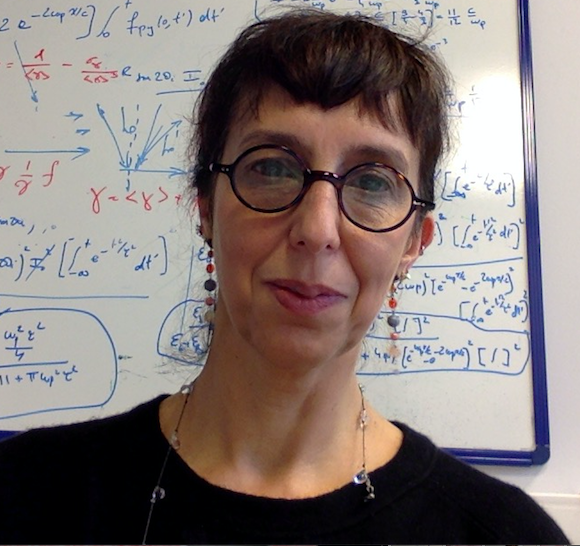
WiP Seminars #1 - Caterina Riconda
About the event
The Women in Physics Student Club is thrilled to announce Prof. Caterina Riconda as the speaker for our first WiP Seminars event.
In the WiP Seminars you have the chance to not only learn about research carried out by internationally renowned physicists, but also participate in an informal conversation with them and ask about their career. Be sure to register!
Our first speaker is a plasma physicist with a particular interest in the interactions between plasma and both lasers and ultra-high-intensity fields. Caterina Riconda is a professor at the Sorbonne University in Paris and leads the “Theory and Interpretation, Plasmas and Simulations” (TIPS) group at the Laboratoire d’Utilisation des Lasers Intenses (LULI).
Date: 19 January 2022 (Wednesday) at 14:00 GMT
Where: Zoom, please register here
Title of the seminar: Relativistic electron acceleration in laser plasma interaction and high intensity plasmonics
Speaker: Prof. Caterina Riconda
Outline:
14:00 - 14:45: Scientific seminar, including time for questions
14:45 - 14:55: Ten-minute break
14:55 - 15:30: Informal conversation with speaker
About the speaker
Caterina Riconda received her Master in the University of Turin, Italy, and her Ph.D. in Physics from the Massachusetts Institute of Technology, USA, in 1996. After appointments at the Joint European Torus, UK, the École Polytechnique, CEA Saclay, and the University of Bordeaux in France, she is now a full professor at the Sorbonne University in Paris. Her research interests include plasma physics, plasma kinetic theory, laser-plasma interactions, and ultra-high-intensity (UHI) field-plasma interactions. She is team leader of the group Theory and Interpretation, Plasmas and Simulations (TIPS) at the Laboratoire d’Utilisation des Lasers Intenses (LULI).

Abstract of the seminar
The availability for the scientific community of compact sources of intense, high-power, ultrashort laser pulses, allowed a rapid growth of studies on laser driven electron accelerators. Different laser plasma acceleration mechanisms have been explored. A by now well know scheme involves the generation of huge acceleration gradients, up to 10 to 100 GV/m, due to the propagation of a TW-class laser pulse in a diluted plasma. GeV scale and very short duration (some fs) electron beams produced in this way are a natural candidate as drivers for a free-electron laser or to be coupled into undulators to produce radiation in the visible and X-ray domain.
After a brief review of these mechanisms, we present an alternative approach: the generation of fast electron beams in relativistic laser-solid interaction. The studies in this domain are mainly stimulated by the possibility of having higher electron currents due to the high density. In laser-solid interaction the energy coupling between the laser beam and the target is mainly localized at the surface and the coupling efficiency needs to be optimized in order to get an energetic electron distribution. One way is to use properly-structured targets whose surface characteristics match with the laser parameters, so that surface plasma waves are excited1. As will be discussed, the surface plasma wave (plasmons) excitation on solid grating target enhances drastically the laser absorption in ultra-high intensity interaction regime ($ I\lambda^2>10^{18} ~ \mathrm{W cm^{-2} \mu m^2} $) and generates large currents of relativistic electrons. Theoretical, numerical (via the Particle-in-Cell method) and experimental studies of fast electron generation will be presented.
Recently, a simple scaling for the conversion of surface wave field energy into electrons kinetic energy has been identified by our group by considering the interaction of test electrons with the evanescent high frequency field of a surface wave2. We were able to show that the most energetic relativistic electrons are accelerated parallel to the plasma-vacuum interface to velocities larger than the wave phase velocity. These results have been confirmed by Particle-in-Cell simulation and experiments3. A new scheme was proposed recently, combining a smart grating design with high intensity laser pulses with wavefront rotation, allowing to tune the duration and intensity of the surface plasma waves, capable of accelerating ultrashort and energetic electron bunches4.
-
J. Kupersztych, M. Raynaud, and C. Riconda, Phys. Plasmas 11, 1669 (2004) ↩︎
-
C. Riconda, et al., Phys. of Plasmas 22, 073103 (2015), and ref. therein ↩︎
-
T. Ceccotti, et al., Phys. Rev. Lett. 111, 185001 (2013); L. Fedeli, et al., Phys. Rev. Lett. 116, 015001 (2016); G. Cantono, et al., Phys. Rev. Lett. 120, 264803 (2018), and ref. therein ↩︎
 Student Club
Student Club